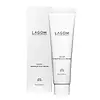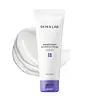What's inside
What's inside
 Key Ingredients
Key Ingredients

No key ingredients
 Benefits
Benefits

 Concerns
Concerns

 Ingredients Side-by-side
Ingredients Side-by-side

Water
Skin ConditioningPanthenol
Skin ConditioningGlycerin
HumectantCetearyl Alcohol
EmollientButylene Glycol
HumectantDipropylene Glycol
HumectantNeopentyl Glycol Dicaprate
EmollientCaprylic/Capric Triglyceride
MaskingHydrogenated Polydecene
EmollientPolyglyceryl-3 Distearate
EmulsifyingVinyldimethicone
Beeswax
Emulsion StabilisingCetearyl Glucoside
EmulsifyingSucrose Polystearate
Emollient1,2-Hexanediol
Skin ConditioningCaprylyl Glycol
EmollientTromethamine
BufferingGlyceryl Stearate Citrate
EmollientCetyl Palmitate
EmollientCarbomer
Emulsion StabilisingHydrogenated Lecithin
EmulsifyingCeramide NP
Skin ConditioningAcrylates/C10-30 Alkyl Acrylate Crosspolymer
Emulsion StabilisingIllicium Verum Fruit Extract
PerfumingGinkgo Biloba Leaf Extract
Skin ConditioningPerilla Frutescens Leaf Extract
MaskingCaesalpinia Sappan Bark Extract
Skin ConditioningPaeonia Lactiflora Root Extract
Skin ConditioningCamellia Sinensis Leaf Extract
AntimicrobialCalcium Chloride
AstringentMagnesium Sulfate
Zinc Oxide
Cosmetic ColorantTrehalose
HumectantBetaine
HumectantMacadamia Ternifolia Seed Oil
EmollientCholesterol
EmollientBrassica Campestris Sterols
EmollientDipotassium Glycyrrhizate
HumectantMadecassoside
AntioxidantAllantoin
Skin ConditioningAsiaticoside
AntioxidantMadecassic Acid
Skin ConditioningAsiatic Acid
Skin ConditioningWater, Panthenol, Glycerin, Cetearyl Alcohol, Butylene Glycol, Dipropylene Glycol, Neopentyl Glycol Dicaprate, Caprylic/Capric Triglyceride, Hydrogenated Polydecene, Polyglyceryl-3 Distearate, Vinyldimethicone, Beeswax, Cetearyl Glucoside, Sucrose Polystearate, 1,2-Hexanediol, Caprylyl Glycol, Tromethamine, Glyceryl Stearate Citrate, Cetyl Palmitate, Carbomer, Hydrogenated Lecithin, Ceramide NP, Acrylates/C10-30 Alkyl Acrylate Crosspolymer, Illicium Verum Fruit Extract, Ginkgo Biloba Leaf Extract, Perilla Frutescens Leaf Extract, Caesalpinia Sappan Bark Extract, Paeonia Lactiflora Root Extract, Camellia Sinensis Leaf Extract, Calcium Chloride, Magnesium Sulfate, Zinc Oxide, Trehalose, Betaine, Macadamia Ternifolia Seed Oil, Cholesterol, Brassica Campestris Sterols, Dipotassium Glycyrrhizate, Madecassoside, Allantoin, Asiaticoside, Madecassic Acid, Asiatic Acid
Water
Skin ConditioningGlycerin
HumectantButylene Glycol
HumectantCetyl Ethylhexanoate
EmollientCyclopentasiloxane
EmollientHydrogenated Poly(C6-14 Olefin)
EmollientPentaerythrityl Tetraethylhexanoate
EmollientDimethicone
EmollientSqualane
Emollient1,2-Hexanediol
Skin ConditioningPolyglyceryl-3 Methylglucose Distearate
EmulsifyingPentylene Glycol
Skin ConditioningGlyceryl Stearate
EmollientHydrogenated Vegetable Oil
EmollientPanthenol
Skin ConditioningStearyl Alcohol
EmollientArachidyl Alcohol
EmollientCetyl Alcohol
EmollientCetearyl Alcohol
EmollientPolymethylsilsesquioxane
Behenyl Alcohol
EmollientHydroxyethyl Acrylate/Sodium Acryloyldimethyl Taurate Copolymer
Emulsion StabilisingMannitol
HumectantGlyceryl Arachidonate
EmollientGlyceryl Linoleate
EmollientGlyceryl Linolenate
EmollientArachidyl Glucoside
EmulsifyingCopernicia Cerifera Wax
Cetearyl Glucoside
EmulsifyingEthylhexylglycerin
Skin ConditioningDipotassium Glycyrrhizate
HumectantHydrogenated Olive Oil Lauryl Esters
Emulsion StabilisingSerine
MaskingXanthan Gum
EmulsifyingGlycine
BufferingLecithin
EmollientSodium Phytate
Arginine
MaskingWater, Glycerin, Butylene Glycol, Cetyl Ethylhexanoate, Cyclopentasiloxane, Hydrogenated Poly(C6-14 Olefin), Pentaerythrityl Tetraethylhexanoate, Dimethicone, Squalane, 1,2-Hexanediol, Polyglyceryl-3 Methylglucose Distearate, Pentylene Glycol, Glyceryl Stearate, Hydrogenated Vegetable Oil, Panthenol, Stearyl Alcohol, Arachidyl Alcohol, Cetyl Alcohol, Cetearyl Alcohol, Polymethylsilsesquioxane, Behenyl Alcohol, Hydroxyethyl Acrylate/Sodium Acryloyldimethyl Taurate Copolymer, Mannitol, Glyceryl Arachidonate, Glyceryl Linoleate, Glyceryl Linolenate, Arachidyl Glucoside, Copernicia Cerifera Wax, Cetearyl Glucoside, Ethylhexylglycerin, Dipotassium Glycyrrhizate, Hydrogenated Olive Oil Lauryl Esters, Serine, Xanthan Gum, Glycine, Lecithin, Sodium Phytate, Arginine
Ingredients Explained
These ingredients are found in both products.
Ingredients higher up in an ingredient list are typically present in a larger amount.
1,2-Hexanediol is a synthetic liquid and another multi-functional powerhouse.
It is a:
- Humectant, drawing moisture into the skin
- Emollient, helping to soften skin
- Solvent, dispersing and stabilizing formulas
- Preservative booster, enhancing the antimicrobial activity of other preservatives
Butylene Glycol (or BG) is used within cosmetic products for a few different reasons:
Overall, Butylene Glycol is a safe and well-rounded ingredient that works well with other ingredients.
Though this ingredient works well with most skin types, some people with sensitive skin may experience a reaction such as allergic rashes, closed comedones, or itchiness.
Learn more about Butylene GlycolCetearyl alcohol is a mixture of two fatty alcohols: cetyl alcohol and stearyl alcohol. It is mainly used as an emulsifier. Emulsifiers help prevent the separation of oils and products. Due to its composition, it can also be used to thicken a product or help create foam.
Cetearyl alcohol is an emollient. Emollients help soothe and hydrate the skin by trapping moisture.
Studies show Cetearyl alcohol is non-toxic and non-irritating. The FDA allows products labeled "alcohol-free" to have fatty alcohols.
This ingredient is usually derived from plant oils such as palm, vegetable, or coconut oils. There is debate on whether this ingredient will cause acne.
Due to the fatty acid base, this ingredient may not be Malassezia folliculitis safe.
Learn more about Cetearyl AlcoholCetearyl Glucoside is a surfactant and emulsifier. It can be produced from synthetic of natural sources of cetearyl alcohol and glucose.
Emulsifiers help prevent ingredients from separating, such as oils and waters. It can also be used to enhance the texture of products.
As a surfactant, Cetearyl Glucoside helps during the cleansing process. By gathering all the dirt and oils, it allows these molecules to be washed away easily.
Learn more about Cetearyl GlucosideDipotassium Glycyrrhizate comes from licorice root.
Extracts of licorice have demonstrated to have antibacterial, anti‐inflammatory, antiviral, antioxidant properties.
One component, glabridin, has extra potent antioxidant and soothing properties. It has also been found to block pigmentation from UVB rays in guinea pigs.
Licorice Root also contains a flavonoid. Flavonoids are a natural substance from in plants. Flavonoids also have antioxidant properties.
Another component, glycyrrhizin, has been found to have anti-inflammatory and antimicrobial benefits. This may make licorice root extract effective at treating acne. However, more research is needed to support this.
Liquiritin is one of the flavone compounds found in licorice. It has been found to help lighten skin by preventing tyrosinase from reacting with tyrosine. When the two react, protein is converted to melanin. Melanin is the substance in your body that gives your features pigmentation.
Licorice root is native to Southern Europe and Asia. It has been used in traditional Chinese medicine to help with respiratory issues.
Learn more about Dipotassium GlycyrrhizateGlycerin is already naturally found in your skin. It helps moisturize and protect your skin.
A study from 2016 found glycerin to be more effective as a humectant than AHAs and hyaluronic acid.
As a humectant, it helps the skin stay hydrated by pulling moisture to your skin. The low molecular weight of glycerin allows it to pull moisture into the deeper layers of your skin.
Hydrated skin improves your skin barrier; Your skin barrier helps protect against irritants and bacteria.
Glycerin has also been found to have antimicrobial and antiviral properties. Due to these properties, glycerin is often used in wound and burn treatments.
In cosmetics, glycerin is usually derived from plants such as soybean or palm. However, it can also be sourced from animals, such as tallow or animal fat.
This ingredient is organic, colorless, odorless, and non-toxic.
Glycerin is the name for this ingredient in American English. British English uses Glycerol/Glycerine.
Learn more about GlycerinPanthenol is a common ingredient that helps hydrate and soothe the skin. It is found naturally in our skin and hair.
There are two forms of panthenol: D and L.
D-panthenol is also known as dexpanthenol. Most cosmetics use dexpanthenol or a mixture of D and L-panthenol.
Panthenol is famous due to its ability to go deeper into the skin's layers. Using this ingredient has numerous pros (and no cons):
Like hyaluronic acid, panthenol is a humectant. Humectants are able to bind and hold large amounts of water to keep skin hydrated.
This ingredient works well for wound healing. It works by increasing tissue in the wound and helps close open wounds.
Once oxidized, panthenol converts to pantothenic acid. Panthothenic acid is found in all living cells.
This ingredient is also referred to as pro-vitamin B5.
Learn more about PanthenolWater. It's the most common cosmetic ingredient of all. You'll usually see it at the top of ingredient lists, meaning that it makes up the largest part of the product.
So why is it so popular? Water most often acts as a solvent - this means that it helps dissolve other ingredients into the formulation.
You'll also recognize water as that liquid we all need to stay alive. If you see this, drink a glass of water. Stay hydrated!
Learn more about Water